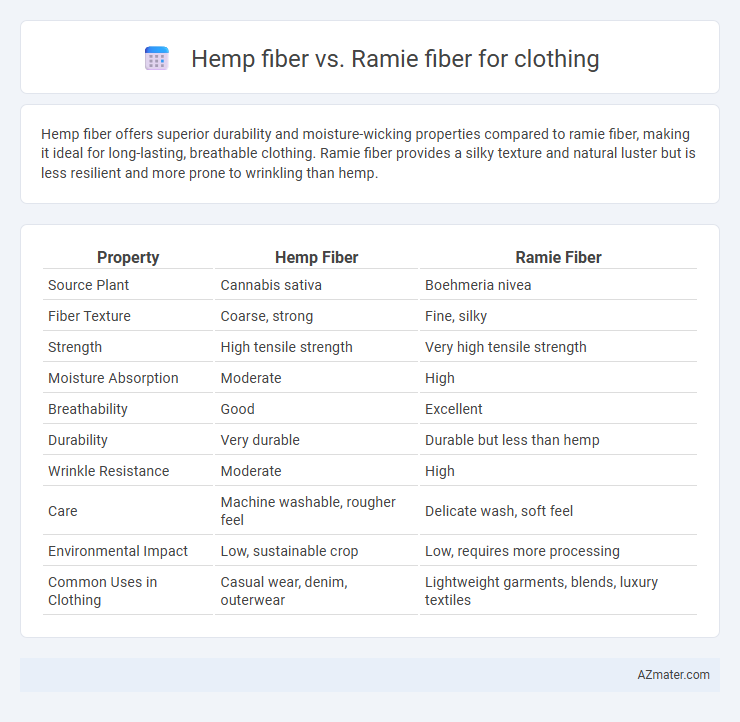Hemp fiber offers superior durability and moisture-wicking properties compared to ramie fiber, making it ideal for long-lasting, breathable clothing. Ramie fiber provides a silky texture and natural luster but is less resilient and more prone to wrinkling than hemp.
Table of Comparison
| Property | Hemp Fiber | Ramie Fiber |
|---|---|---|
| Source Plant | Cannabis sativa | Boehmeria nivea |
| Fiber Texture | Coarse, strong | Fine, silky |
| Strength | High tensile strength | Very high tensile strength |
| Moisture Absorption | Moderate | High |
| Breathability | Good | Excellent |
| Durability | Very durable | Durable but less than hemp |
| Wrinkle Resistance | Moderate | High |
| Care | Machine washable, rougher feel | Delicate wash, soft feel |
| Environmental Impact | Low, sustainable crop | Low, requires more processing |
| Common Uses in Clothing | Casual wear, denim, outerwear | Lightweight garments, blends, luxury textiles |
Introduction to Hemp and Ramie Fibers
Hemp fiber, derived from the Cannabis sativa plant stalk, is renowned for its durability, breathability, and moisture-wicking properties, making it a sustainable choice for eco-friendly clothing. Ramie fiber, obtained from the stalks of the Boehmeria nivea plant, offers a silky luster, high tensile strength, and resistance to bacterial attacks, enhancing garment longevity and comfort. Both fibers are natural bast fibers widely used in textiles, with hemp favored for rugged apparel and ramie prized for luxurious fabrics.
Botanical Origins of Hemp and Ramie
Hemp fiber originates from the stalks of the Cannabis sativa plant, a fast-growing herbaceous species known for its strong and durable fibers, widely used in eco-friendly textile production. Ramie fiber is derived from the stalks of Boehmeria nivea, a flowering plant in the nettle family Urticaceae, prized for its silky luster and resistance to bacterial attack in fabric applications. Both fibers are natural bast fibers extracted through retting processes but differ significantly in botanical classification and fiber characteristics influencing their suitability for sustainable clothing.
Fiber Extraction Processes
Hemp fiber extraction primarily involves water retting or enzymatic retting to separate the bast fibers from the stalk, followed by mechanical decortication to remove the woody core. Ramie fiber extraction uses similar processes, but it relies heavily on degumming, a chemical treatment to remove gums and pectins that bind the fibers, enhancing its softness and luster. Compared to hemp, ramie requires more intensive processing steps to achieve the fine, lustrous fibers desired for high-quality clothing textiles.
Physical Properties Comparison
Hemp fiber offers superior tensile strength and durability compared to ramie fiber, making it ideal for long-lasting clothing. Ramie fiber, however, excels in moisture absorption and has a silkier texture, enhancing comfort and breathability in garments. Both fibers provide excellent UV resistance, but hemp's coarser texture gives it enhanced abrasion resistance, suited for rugged apparel.
Sustainability and Environmental Impact
Hemp fiber outperforms ramie fiber in sustainability due to its rapid growth, minimal pesticide use, and ability to improve soil health through phytoremediation. Ramie fiber, while biodegradable and requiring less water than cotton, involves heavy chemical processing that increases environmental pollution. Choosing hemp fiber for clothing significantly reduces carbon footprint and supports regenerative agriculture practices.
Comfort and Wearability in Clothing
Hemp fiber offers excellent durability and breathability, making it suitable for comfortable, long-lasting clothing with natural moisture-wicking properties. Ramie fiber is exceptionally soft, smooth, and lightweight, providing superior comfort and a silky feel ideal for sensitive skin and lightweight garments. Both fibers excel in wearability, but ramie often outperforms hemp in softness, while hemp provides greater strength and resistance to abrasion.
Durability and Longevity in Apparel
Hemp fiber is renowned for its exceptional durability and resistance to wear, making it ideal for long-lasting clothing that withstands frequent use and washing. Ramie fiber offers impressive strength as well, but it is more prone to brittleness and requires blending with other materials to enhance its longevity in apparel. The natural resilience of hemp ensures that garments retain their shape and integrity over time, outperforming ramie in terms of durability for everyday wear.
Dyeing and Finishing Techniques
Hemp fiber exhibits excellent dye absorption due to its porous structure, allowing vibrant and long-lasting colors with natural or synthetic dyes, while ramie fiber's smooth surface can result in less uniform dye uptake, often requiring mordants or cationic dyeing techniques to improve color fastness. Finishing techniques for hemp include enzyme treatments and softeners to enhance fabric softness and reduce rigidity, whereas ramie benefits from chemical finishes that increase flexibility and reduce brittleness for comfortable wear. Both fibers respond well to eco-friendly dyeing and finishing processes, aligning with sustainable fashion trends focused on reducing environmental impact.
Cost and Market Availability
Hemp fiber typically costs less than ramie fiber due to its widespread cultivation and sustainable production methods, making it a more affordable option for clothing manufacturers. Ramie fiber, though valued for its silky texture and durability, is less commonly produced and processed, resulting in higher prices and limited market availability. The global market favors hemp fiber for its cost-efficiency and scalability, while ramie remains a niche choice primarily found in specialty textile segments.
Conclusion: Choosing Between Hemp and Ramie for Clothing
Hemp fiber offers superior durability, moisture-wicking properties, and natural resistance to UV rays, making it ideal for rugged, breathable clothing. Ramie fiber excels in softness, luster, and ease of dyeing, providing a smooth texture suitable for lightweight, elegant garments. Choosing between hemp and ramie depends on the desired balance of strength and comfort for specific clothing applications.

Infographic: Hemp fiber vs Ramie fiber for Clothing
 azmater.com
azmater.com